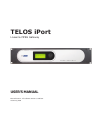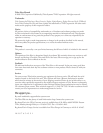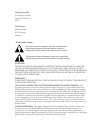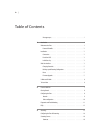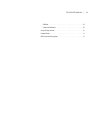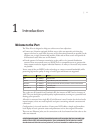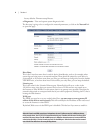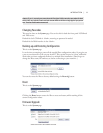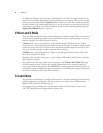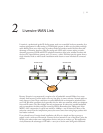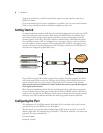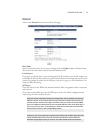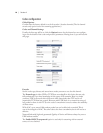
2 | Section 1
loss is routine such as on the public Internet. There are congurable buers to accommodate jitter, but longer
buer lengths add to delay. When you need to use non-QoS-controlled links, the Telos Z/IP family products are a
better choice because they have adaptive mechanisms to deal with network problems.
Features & Benets
e iPort is an innovative approach to providing MPEG codec functionality, made possible by
the use of Livewire for its audio interface. Its features include:
High density. 8x8 codec or 16 encode-only channels in a 2U box.
♦
Low cost. We’ve built the iPort on a single industrial PC motherboard rather than on the ♦
usual multiple DSP cards in a frame approach. Together with the Livewire-only audio
interface, we are able to manufacture the iPort at a fraction of the cost of the traditional way.
Direct Livewire connectivity. For people who already have facilities based on Livewire IP
♦
audio, there is no need for any interface or conversion. e iPort simply plugs into a port on
the Ethernet switch and all encode/decode channels are connected with 24-bit/48kHz quality.
Web configuration. Can be done with a PC located anywhere on the network.
♦
Full range of state-of-the-art MPEG codecs. AAC-LD for delay-sensitive applications, ♦
AAC-HE and AAC-HEv2 for low bitrate requirements. Standard AAC for best quality and
resilience to packet loss at higher bitrates.
Excellent quality and high-density streaming encoder with the advantage of the Livewire IP
♦
Audio network interface.
Installation
e iPort mounts in a 2RU high space in a standard 19” rack. e unit will operate in any
environment where the stirred air temperature around the unit is between 0 to 40 degrees
Celsius (32 to 104 degrees Fahrenheit) with a relative humidly of 0 to 98% (non-condensing).
ere are redundant ventilation fans on the rear panel which exhaust air that is taken in from
openings in the box sides. All of these need to remain unobstructed.
e fan speed is controlled automatically, and is normally quite slow. If the fans are running at
high speed, or if there is an over-temperature indication on the front panel LCD, a problem
with air flow or high ambient temperature is probably to blame.
Connections
All audio input/output and control is via two rear-panel Ethernet Rj-45 jacks. e jack labeled
Livewire is for connection of studio-side audio.



